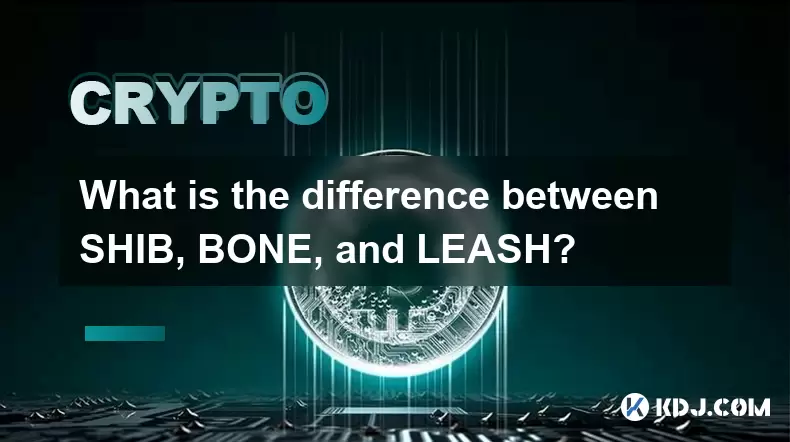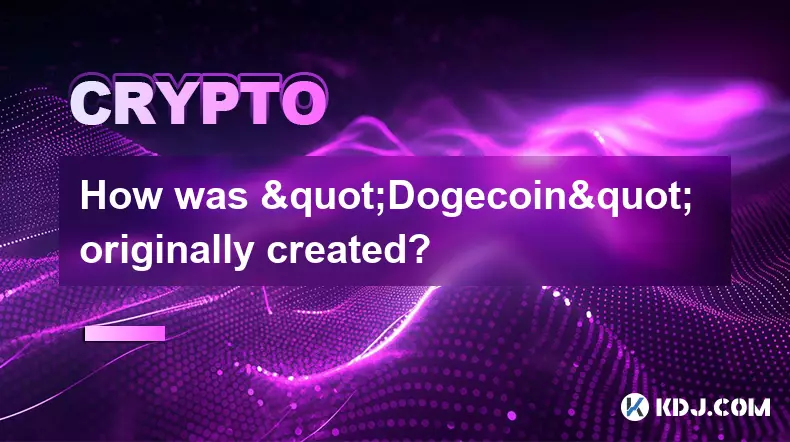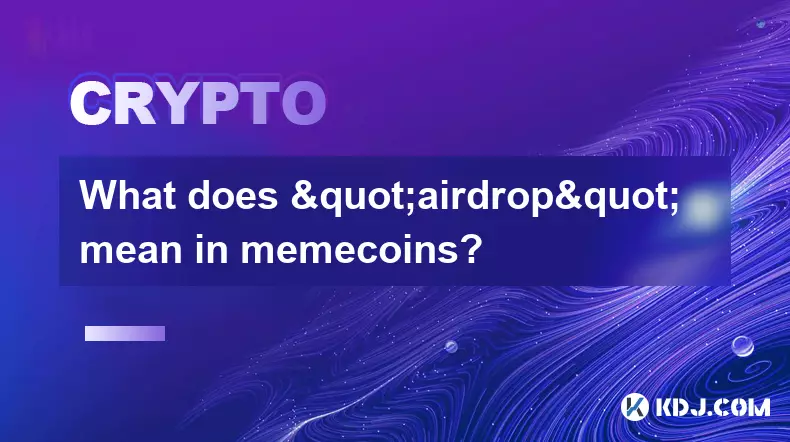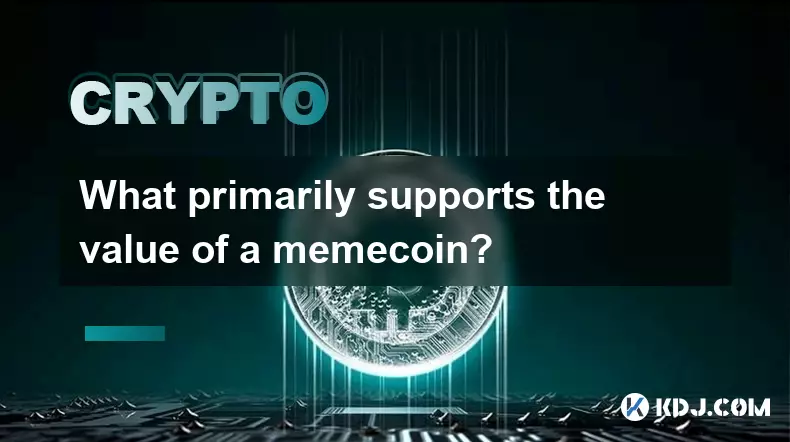-
 bitcoin
bitcoin $124586.364639 USD
0.62% -
 ethereum
ethereum $4670.671710 USD
3.33% -
 xrp
xrp $2.983701 USD
0.18% -
 tether
tether $1.000175 USD
-0.03% -
 bnb
bnb $1209.430642 USD
2.76% -
 solana
solana $231.365861 USD
0.51% -
 usd-coin
usd-coin $0.999665 USD
-0.02% -
 dogecoin
dogecoin $0.264657 USD
4.46% -
 tron
tron $0.346415 USD
1.60% -
 cardano
cardano $0.871586 USD
3.70% -
 chainlink
chainlink $23.451270 USD
7.56% -
 hyperliquid
hyperliquid $46.860071 USD
-2.96% -
 ethena-usde
ethena-usde $1.000120 USD
0.04% -
 sui
sui $3.611279 USD
1.08% -
 stellar
stellar $0.407149 USD
0.96%
What is the difference between SHIB, BONE, and LEASH?
The Shiba Inu ecosystem features three main tokens—SHIB, BONE, and LEASH—each serving distinct roles in transactions, governance, and speculation.
Jul 31, 2025 at 09:31 pm

Understanding the Shibas in the Shiba Inu Ecosystem
The Shiba Inu ecosystem includes several tokens that serve different purposes within the decentralized finance (DeFi) space. Among the most notable are SHIB, BONE, and LEASH. Each of these tokens plays a unique role in the broader Shiba Inu project, which was launched as a meme-based cryptocurrency inspired by the popular Shiba Inu dog breed.
What is SHIB?
SHIB is the primary and most well-known token of the Shiba Inu ecosystem. Often referred to as the 'Dogecoin killer,' SHIB is an ERC-20 token built on the Ethereum blockchain. It was created by an anonymous individual or group known as Ryoshi with the intention of offering a decentralized community-driven token.
- Supply: SHIB has a total supply of 1 quadrillion tokens, which is an astronomically high number compared to other cryptocurrencies.
- Use Case: It functions as a medium of exchange and store of value within the ecosystem.
- Decentralized Exchange: The ShibaSwap platform allows users to trade SHIB and other tokens without intermediaries.
- Community Governance: While not the primary governance token, SHIB holders can participate in community discussions and proposals.
What is BONE?
BONE is the governance token of the Shiba Inu ecosystem. Unlike SHIB, which is used for transactions and as a speculative asset, BONE gives holders the power to influence the future development of the ecosystem through voting rights.
- Supply: BONE has a limited supply of 250 million tokens, making it more scarce than SHIB.
- Voting Power: To participate in governance, users must stake their BONE tokens.
- Staking: BONE can be staked to earn rewards and gain voting rights on proposals related to ShibaSwap and other ecosystem developments.
- Acquisition: BONE can be obtained by providing liquidity on ShibaSwap or by purchasing it on supported exchanges.
What is LEASH?
LEASH was initially designed as a rebase token pegged to the price of Dogecoin (DOGE). However, due to a contract error, it became a free-floating token. Today, LEASH serves as a speculative asset within the Shiba Inu ecosystem.
- Supply: LEASH has a limited supply of approximately 107,000 tokens, making it significantly rarer than SHIB and BONE.
- Historical Purpose: Originally intended to be a DOGE derivative, LEASH now operates independently.
- Volatility: Due to its low supply and speculative nature, LEASH tends to be more volatile than SHIB and BONE.
- Use Case: It functions primarily as a speculative investment, with no direct utility in governance or transactions.
How Do SHIB, BONE, and LEASH Interact?
The three tokens work together to support the Shiba Inu ecosystem, each contributing in a different capacity.
- SHIB is used for trading and as a liquidity asset on ShibaSwap.
- BONE enables governance and decision-making, allowing holders to shape the future of the platform.
- LEASH acts as a speculative token, often used by traders looking for high-risk, high-reward opportunities.
Users can earn BONE by providing liquidity with SHIB on ShibaSwap, and they can trade LEASH like any other token on supported exchanges.
Where to Buy and Store These Tokens?
All three tokens — SHIB, BONE, and LEASH — can be purchased on major cryptocurrency exchanges such as Binance, KuCoin, and Bybit.
- Wallet Compatibility: Since these tokens are built on the Ethereum blockchain, they can be stored in any ERC-20 compatible wallet such as MetaMask, Trust Wallet, or Ledger.
- ShibaSwap Integration: Users who wish to stake or farm BONE or provide liquidity should connect their wallets to ShibaSwap.
- Security: Always ensure you are using the correct contract addresses for each token to avoid scams or phishing attempts.
Frequently Asked Questions
Q1: Can I mine SHIB, BONE, or LEASH?No, none of these tokens can be mined. They are all pre-minted and distributed through mechanisms like liquidity farming, staking, or direct trading on exchanges.
Q2: Is there a risk of one token replacing another in the ecosystem?Each token serves a distinct role. SHIB is the main utility token, BONE handles governance, and LEASH is a speculative asset. There is no indication that one will replace another.
Q3: How often are BONE rewards distributed?BONE rewards are distributed based on the liquidity provided and the duration of staking on ShibaSwap. There is no fixed schedule; it depends on the pool's performance.
Q4: Can I use SHIB to pay for goods and services?While SHIB is accepted by some merchants and platforms, its adoption as a payment method is limited compared to more established cryptocurrencies like Bitcoin or Ethereum.
Disclaimer:info@kdj.com
The information provided is not trading advice. kdj.com does not assume any responsibility for any investments made based on the information provided in this article. Cryptocurrencies are highly volatile and it is highly recommended that you invest with caution after thorough research!
If you believe that the content used on this website infringes your copyright, please contact us immediately (info@kdj.com) and we will delete it promptly.
- BlockDAG, DOGE, HYPE Sponsorship: Crypto Trends Shaping 2025
- 2025-10-01 00:25:13
- Deutsche Börse and Circle: A StableCoin Adoption Powerhouse in Europe
- 2025-10-01 00:25:13
- BlockDAG's Presale Buzz: Is It the Crypto to Watch in October 2025?
- 2025-10-01 00:30:13
- Bitcoin, Crypto, and IQ: When Genius Meets Digital Gold?
- 2025-10-01 00:30:13
- Stablecoins, American Innovation, and Wallet Tokens: The Next Frontier
- 2025-10-01 00:35:12
- NBU, Coins, and Crypto in Ukraine: A New Yorker's Take
- 2025-10-01 00:45:14
Related knowledge

What is the relationship between "Shiba Inu" and "Dogecoin"?
Sep 19,2025 at 08:36pm
Origins and Inspiration Behind Shiba Inu and Dogecoin1. Dogecoin was created in 2013 by software engineers Billy Markus and Jackson Palmer as a lighth...

How was "Bitcoincoin" originally created?
Sep 17,2025 at 07:18pm
Origins of Dogecoin in the Cryptocurrency Landscape1. Dogecoin was introduced to the digital currency world in December 2013 by software engineers Bil...

Do memecoins have real uses?
Sep 19,2025 at 03:54am
Understanding the Role of Memecoins in the Crypto Ecosystem1. Memecoins originated as internet joke currencies, often inspired by viral memes or pop c...

Where can I buy memecoins?
Sep 18,2025 at 02:18pm
Popular Platforms for Acquiring Memecoins1. Centralized exchanges like Binance, OKX, and Bybit have become primary destinations for traders seeking ne...

What does "airdrop" mean in memecoins?
Sep 21,2025 at 06:19pm
Understanding Airdrops in the Memecoin Ecosystem1. An airdrop in the context of memecoins refers to the distribution of free tokens to wallet addresse...

What primarily supports the value of a memecoin?
Sep 17,2025 at 10:19pm
Community Influence and Social Momentum1. The primary driver behind the value of a memecoin is its community engagement. A strong, active, and passion...

What is the relationship between "Shiba Inu" and "Dogecoin"?
Sep 19,2025 at 08:36pm
Origins and Inspiration Behind Shiba Inu and Dogecoin1. Dogecoin was created in 2013 by software engineers Billy Markus and Jackson Palmer as a lighth...

How was "Bitcoincoin" originally created?
Sep 17,2025 at 07:18pm
Origins of Dogecoin in the Cryptocurrency Landscape1. Dogecoin was introduced to the digital currency world in December 2013 by software engineers Bil...

Do memecoins have real uses?
Sep 19,2025 at 03:54am
Understanding the Role of Memecoins in the Crypto Ecosystem1. Memecoins originated as internet joke currencies, often inspired by viral memes or pop c...

Where can I buy memecoins?
Sep 18,2025 at 02:18pm
Popular Platforms for Acquiring Memecoins1. Centralized exchanges like Binance, OKX, and Bybit have become primary destinations for traders seeking ne...

What does "airdrop" mean in memecoins?
Sep 21,2025 at 06:19pm
Understanding Airdrops in the Memecoin Ecosystem1. An airdrop in the context of memecoins refers to the distribution of free tokens to wallet addresse...

What primarily supports the value of a memecoin?
Sep 17,2025 at 10:19pm
Community Influence and Social Momentum1. The primary driver behind the value of a memecoin is its community engagement. A strong, active, and passion...
See all articles










































































